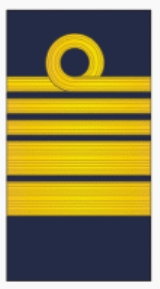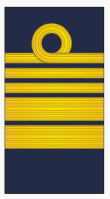
Naval ranks of the Japanese Empire during World War II
Encyclopedia
The following graphs present the rank insignia of the Japanese
navy
during World War II
. These designs had been used from 1931-1945, but were discontinued after World War II, when the Imperial Japanese Navy
had been dissolved.
The same officer ranks were used for both the Imperial Japanese Army and Imperial Japanese Navy, the only distinction being the placement of the word Rikugun (Army) or Kaigun (Navy) before the rank. Thus, for example, a Captain in the navy shared the same rank designation as that of a Colonel in the Army-Taisa (Colonel), so the rank of "Rikugun Taisa" denoted an Army Colonel while the rank of "Kaigun Daisa" denoted a Naval Captain.
Japan
Japan is an island nation in East Asia. Located in the Pacific Ocean, it lies to the east of the Sea of Japan, China, North Korea, South Korea and Russia, stretching from the Sea of Okhotsk in the north to the East China Sea and Taiwan in the south...
navy
Navy
A navy is the branch of a nation's armed forces principally designated for naval and amphibious warfare; namely, lake- or ocean-borne combat operations and related functions...
during World War II
World War II
World War II, or the Second World War , was a global conflict lasting from 1939 to 1945, involving most of the world's nations—including all of the great powers—eventually forming two opposing military alliances: the Allies and the Axis...
. These designs had been used from 1931-1945, but were discontinued after World War II, when the Imperial Japanese Navy
Imperial Japanese Navy
The Imperial Japanese Navy was the navy of the Empire of Japan from 1869 until 1947, when it was dissolved following Japan's constitutional renunciation of the use of force as a means of settling international disputes...
had been dissolved.
The same officer ranks were used for both the Imperial Japanese Army and Imperial Japanese Navy, the only distinction being the placement of the word Rikugun (Army) or Kaigun (Navy) before the rank. Thus, for example, a Captain in the navy shared the same rank designation as that of a Colonel in the Army-Taisa (Colonel), so the rank of "Rikugun Taisa" denoted an Army Colonel while the rank of "Kaigun Daisa" denoted a Naval Captain.
Commissioned officer ranks
| All-forces ranks | IJN Insignia |
|---|---|
| 海軍大将 Kaigun Taishō (Admiral Admiral Admiral is the rank, or part of the name of the ranks, of the highest naval officers. It is usually considered a full admiral and above vice admiral and below admiral of the fleet . It is usually abbreviated to "Adm" or "ADM"... ) |
 |
| 海軍中将 Kaigun Chūjō (Vice-Admiral) |
|
| 海軍少将 Kaigun Shōshō (Rear-Admiral) |
|
| 海軍大佐 Kaigun Daisa (Captain Captain (naval) Captain is the name most often given in English-speaking navies to the rank corresponding to command of the largest ships. The NATO rank code is OF-5, equivalent to an army full colonel.... ) |
|
| 海軍中佐 Kaigun Chūsa (Commander Commander Commander is a naval rank which is also sometimes used as a military title depending on the individual customs of a given military service. Commander is also used as a rank or title in some organizations outside of the armed forces, particularly in police and law enforcement.-Commander as a naval... ) |
|
| 海軍少佐 Kaigun Shōsa (Lieutenant-Commander) |
|
| 海軍大尉 Kaigun Daii (Lieutenant Lieutenant A lieutenant is a junior commissioned officer in many nations' armed forces. Typically, the rank of lieutenant in naval usage, while still a junior officer rank, is senior to the army rank... ) |
|
| 海軍中尉 Kaigun Chūi (Sub-Lieutenant Sub-Lieutenant Sub-lieutenant is a military rank. It is normally a junior officer rank.In many navies, a sub-lieutenant is a naval commissioned or subordinate officer, ranking below a lieutenant. In the Royal Navy the rank of sub-lieutenant is equivalent to the rank of lieutenant in the British Army and of... /Lieutenant Junior Grade) |
|
| 海軍少尉 Kaigun Shōi (Ensign Ensign An ensign is a national flag when used at sea, in vexillology, or a distinguishing token, emblem, or badge, such as a symbol of office in heraldry... ) |
|
Cadet and Warrant officer ranks
| All-forces ranks | IJN Insignia |
|---|---|
| 海軍准尉 Kaigun Jun-i (Warrant Officer Warrant Officer A warrant officer is an officer in a military organization who is designated an officer by a warrant, as distinguished from a commissioned officer who is designated an officer by a commission, or from non-commissioned officer who is designated an officer by virtue of seniority.The rank was first... ) |
Single 1/4 in. gold stripe with loop. |
| 海軍少尉候補生 Kaigun Shōi Kōhōsei (Midshipman Midshipman A midshipman is an officer cadet, or a commissioned officer of the lowest rank, in the Royal Navy, United States Navy, and many Commonwealth navies. Commonwealth countries which use the rank include Australia, New Zealand, South Africa, India, Pakistan, Singapore, Sri Lanka and Kenya... ) |
Single 1/4 in. gold stripe |
Enlisted ranks
All warrant and commissioned officer ranks had the same names as their army counterparts. For non-commissioned officers and enlisted, the naming changed in 1942. The first name is before, the second after that date. Both of them were different from the army names, but were equal in rank.| Before 1942 | After 1942 | |
|---|---|---|
| Non-commissioned officers 下士官 (Kashikan) - selected from conscripts and given one year of training in the Navy NCO Academy. | ||
| 一等兵曹 Ittōheisō Petty Officer Petty Officer A petty officer is a non-commissioned officer in many navies and is given the NATO rank denotion OR-6. They are equal in rank to sergeant, British Army and Royal Air Force. A Petty Officer is superior in rank to Leading Rate and subordinate to Chief Petty Officer, in the case of the British Armed... First Class |
上等兵曹 Jōtōheisō Chief Petty Officer Chief Petty Officer A chief petty officer is a senior non-commissioned officer in many navies and coast guards.-Canada:"Chief Petty Officer" refers to two ranks in the Canadian Navy... |
|
| 二等兵曹 Nitōheisō Petty Officer Petty Officer A petty officer is a non-commissioned officer in many navies and is given the NATO rank denotion OR-6. They are equal in rank to sergeant, British Army and Royal Air Force. A Petty Officer is superior in rank to Leading Rate and subordinate to Chief Petty Officer, in the case of the British Armed... Second Class |
一等兵曹 Ittōheisō Petty Officer Petty Officer A petty officer is a non-commissioned officer in many navies and is given the NATO rank denotion OR-6. They are equal in rank to sergeant, British Army and Royal Air Force. A Petty Officer is superior in rank to Leading Rate and subordinate to Chief Petty Officer, in the case of the British Armed... First Class |
|
| 三等兵曹 Santōheisō Petty Officer Petty Officer A petty officer is a non-commissioned officer in many navies and is given the NATO rank denotion OR-6. They are equal in rank to sergeant, British Army and Royal Air Force. A Petty Officer is superior in rank to Leading Rate and subordinate to Chief Petty Officer, in the case of the British Armed... Third Class |
二等兵曹 Nitōheisō Petty Officer Petty Officer A petty officer is a non-commissioned officer in many navies and is given the NATO rank denotion OR-6. They are equal in rank to sergeant, British Army and Royal Air Force. A Petty Officer is superior in rank to Leading Rate and subordinate to Chief Petty Officer, in the case of the British Armed... Second Class |
|
| Enlisted/seamen 兵 (Hei) | ||
| 一等水兵 Ittōsuihei Sailor Sailor A sailor, mariner, or seaman is a person who navigates water-borne vessels or assists in their operation, maintenance, or service. The term can apply to professional mariners, military personnel, and recreational sailors as well as a plethora of other uses... First Class |
水兵長 Suiheichō Leading Seaman Leading Seaman Leading seaman is a junior non-commissioned rank or rate in navies, particularly those of the Commonwealth. When it is used by NATO nations, leading seaman has the rank code of OR-4. It is often equivalent to the army and air force rank of corporal and some navies use corporal rather than... |
|
| 二等水兵 Nitōsuihei Sailor Sailor A sailor, mariner, or seaman is a person who navigates water-borne vessels or assists in their operation, maintenance, or service. The term can apply to professional mariners, military personnel, and recreational sailors as well as a plethora of other uses... Second Class |
上等水兵 Jōtōsuihei Able Seaman Able seaman An able seaman is an unlicensed member of the deck department of a merchant ship. An AB may work as a watchstander, a day worker, or a combination of these roles.-Watchstander:... |
|
| 三等水兵 Santōsuihei Sailor Sailor A sailor, mariner, or seaman is a person who navigates water-borne vessels or assists in their operation, maintenance, or service. The term can apply to professional mariners, military personnel, and recreational sailors as well as a plethora of other uses... Third Class |
一等水兵 Ittōsuihei Seaman Seaman Seaman is one of the lowest ranks in a Navy. In the Commonwealth it is the lowest rank in the Navy, followed by Able Seaman and Leading Seaman, and followed by the Petty Officer ranks.... |
|
| 四等水兵 Yontōsuihei Sailor Sailor A sailor, mariner, or seaman is a person who navigates water-borne vessels or assists in their operation, maintenance, or service. The term can apply to professional mariners, military personnel, and recreational sailors as well as a plethora of other uses... Fourth Class |
二等水兵 Nitōsuihei Seaman Recruit Seaman Recruit Seaman recruit is the lowest enlisted rank in the U.S. Navy and U.S. Coast Guard, just below seaman apprentice; this rank was formerly known as seaman third class... |
|
See also
- Army ranks of the Japanese Empire during World War IIArmy ranks of the Japanese Empire during World War IIThe following tables present the rank insignia of the Japanese military before and during World War II. These designs were worn on shoulders as passants between the years 1911 and 1938, then on collars afterwards until 1945, when the Imperial Japanese Army was dissolved.- Officer ranks :- Enlisted...
- Comparative military ranksComparative military ranksThis article is a list of various states' armed forces ranking designations. Comparisons are made between the different systems used by nations to categorize the hierarchy of an armed force compared to another. Several of these lists mention NATO reference codes. These are the NATO rank reference...
- Military of Japan
- Military rankMilitary rankMilitary rank is a system of hierarchical relationships in armed forces or civil institutions organized along military lines. Usually, uniforms denote the bearer's rank by particular insignia affixed to the uniforms...

